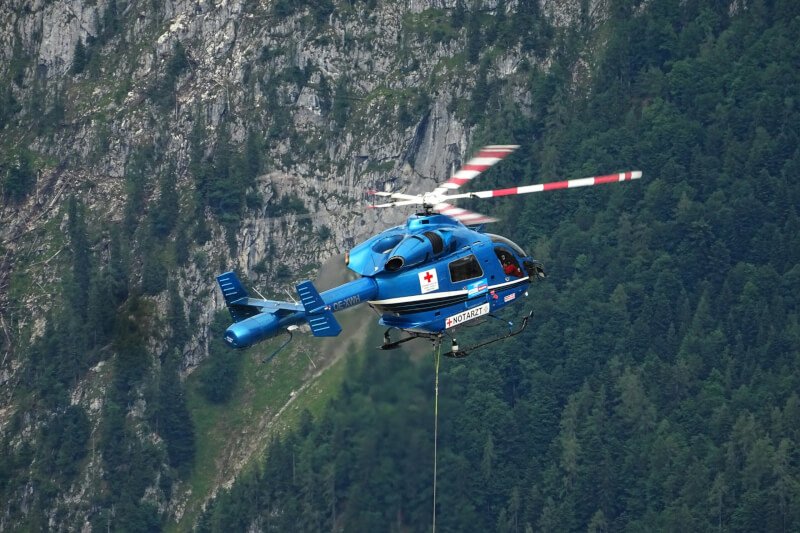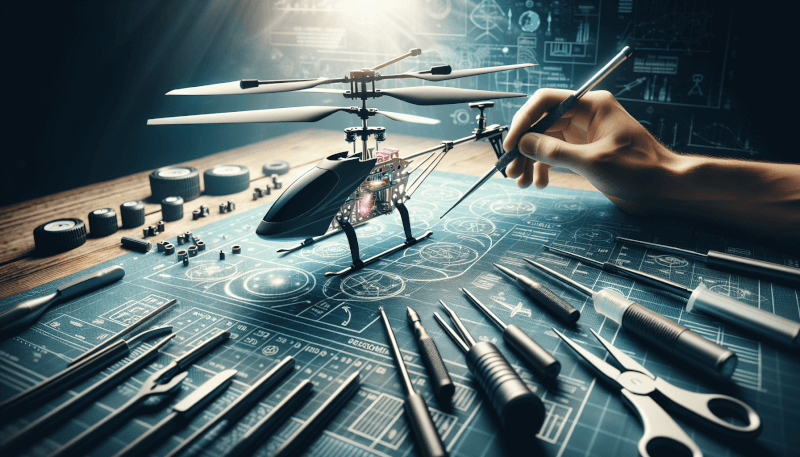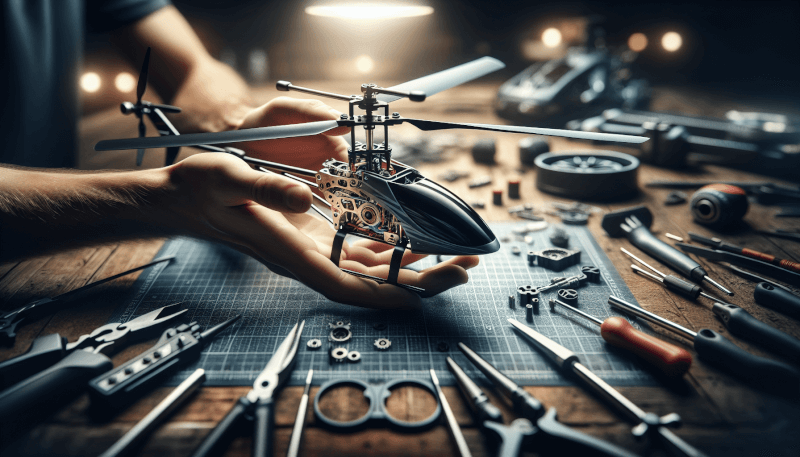Are you ready to take your RC helicopter flying skills to the next level? If so, then it’s time to fine-tune your RC heli’s performance. In this article, we will explore the essential steps and techniques to optimize your RC helicopter’s performance and enhance your overall flying experience. From adjusting the rotor blade pitch to optimizing the gyro settings, we will guide you through the process of fine-tuning your RC heli like a pro. So, grab your heli and let’s get started on the journey towards mastering the skies.
1. Understanding the Basics of RC Helicopters
RC helicopters are a popular hobby among enthusiasts of all ages. These miniature flying machines offer a unique and thrilling experience, allowing you to take control and navigate the skies. Before diving into the world of RC helicopters, it’s essential to understand the basics.
1.1 Different Types of RC Helicopters
There are various types of RC helicopters available, each with its own unique characteristics and capabilities. The most common types include:
- Fixed-Pitch Helicopters: These helicopters have fixed-pitch rotor blades, which means that the angle of the blades remains constant during flight. They are generally more stable and easier to fly, making them ideal for beginners.
- Collective-Pitch Helicopters: Unlike fixed-pitch helicopters, collective-pitch helicopters allow you to control the pitch angle of the rotor blades, resulting in improved maneuverability and aerobatic capabilities.
- Scale Model Helicopters: Scale model helicopters replicate real-life helicopters, offering a realistic flying experience. They are often used for visual displays and are popular among hobbyists who enjoy the aesthetic appeal of these intricate models.
1.2 Components of an RC Helicopter
To understand how to fine-tune your RC helicopter’s performance, it’s crucial to familiarize yourself with its components. Common components of an RC helicopter include:
- Main Rotor: The main rotor is responsible for generating lift and controlling the helicopter’s altitude.
- Tail Rotor: The tail rotor counteracts the torque generated by the main rotor, ensuring stability and preventing the helicopter from spinning.
- Gyroscope: The gyroscope plays a vital role in stabilizing the helicopter, maintaining its orientation and preventing unwanted movements.
- Flight Controls: RC helicopters are equipped with various flight controls, including the cyclic, collective, and tail rotor controls. These controls allow you to maneuver the helicopter in different directions and perform aerobatic maneuvers.
1.3 Understanding Flight Controls
Mastering the flight controls is essential for achieving optimum performance with your RC helicopter. The flight controls consist of the cyclic, collective, and tail rotor controls.
- Cyclic Control: The cyclic control allows you to control the pitch of the main rotor blades individually, resulting in directional movement. Pushing the cyclic control stick forward or backward tilts the helicopter forward or backward, while moving it left or right causes lateral movements.
- Collective Control: The collective control manages the pitch of all the main rotor blades simultaneously. Raising the collective control stick increases the pitch angle, generating more lift and causing the helicopter to ascend. Conversely, lowering the collective control stick reduces the pitch angle, leading to a decrease in lift and descent.
- Tail Rotor Control: The tail rotor control, as its name suggests, controls the tail rotor’s pitch and speed. It compensates for the torque generated by the main rotor, allowing the helicopter to maintain a stable heading. Adjusting the tail rotor control stick alters the direction or yaw of the helicopter.
2. Choosing the Right Helicopter for Fine-Tuning
Selecting the right RC helicopter is crucial for fine-tuning its performance according to your preferences and skill level. Consider the following factors when choosing your helicopter:
2.1 Assessing Skill Level
Before purchasing an RC helicopter, evaluate your skill level as a pilot. If you’re a beginner, it’s advisable to start with a more stable and forgiving helicopter, such as a fixed-pitch model. These models are easier to control and provide a smoother learning curve. On the other hand, if you have experience in flying RC helicopters or other aircraft, you may opt for a collective-pitch helicopter that offers more maneuverability and aerobatic capabilities.
2.2 Considering Helicopter Size
Helicopter size plays a crucial role in its performance and flying characteristics. Larger helicopters tend to be more stable and capable of carrying heavier payloads, while smaller helicopters offer greater agility and maneuverability. Consider your flying environment and personal preferences when selecting the size of your RC helicopter.
2.3 Evaluating Features and Specifications
Different RC helicopters come with a range of features and specifications that can significantly impact their performance. Pay attention to features such as flight modes, stabilization systems, and servos. Additionally, consider the power system, including the motor, ESC (Electronic Speed Controller), and battery requirements. Researching and understanding these features will help you choose the helicopter that best suits your needs and goals.

3. Maintaining and Preparing Your RC Heli
Proper maintenance and preparation are critical for keeping your RC helicopter in optimal condition and ensuring a safe and enjoyable flying experience.
3.1 Regular Cleaning and Inspection
Regular cleaning and inspection of your RC helicopter are essential to prevent dirt, debris, and moisture from affecting its performance. Inspect the rotor blades, frame, and electronics for any signs of damage or wear. Clean the helicopter using a soft brush and compressed air to remove dust and debris.
3.2 Lubrication and Maintenance Tips
Applying lubrication to certain parts of your RC helicopter can improve its performance and longevity. Pay attention to the bearings, gears, and drivetrain components, and use appropriate lubricants recommended by the manufacturer. Additionally, ensure that all screws and connectors are tightened and secure to prevent any potential issues during flight.
3.3 Proper Battery Care
The battery is a crucial component of an RC helicopter, and proper care and maintenance are essential to maximize its lifespan and performance. Follow the manufacturer’s guidelines for charging and discharging the battery, and avoid overcharging or discharging it completely. Store the battery in a cool and dry place when not in use, and monitor its voltage regularly to ensure it is within the safe range.
4. Balancing and Adjusting the Blades
Blade balancing is crucial for smooth and stable flight characteristics. Properly balanced blades reduce vibration, improve maneuverability, and enhance overall performance.
4.1 Understanding Blade Tracking
Blade tracking refers to the alignment and synchronization of the main rotor blades. It ensures that all blades are at the same level during rotation, minimizing vibrations and uneven lift distribution. Use a tracking tool or visually inspect the blade tips to ensure they are aligned.
4.2 Balancing the Main Rotor Blades
Balancing the main rotor blades involves evenly distributing their weight to minimize vibrations. Start by attaching the blades to a balancing tool and identify any imbalances. Use tape or small weights to counterbalance the blades until they are evenly balanced.
4.3 Adjusting Collective Pitch
The collective pitch setting determines the angle of the main rotor blades and directly affects lift and maneuverability. Adjusting the collective pitch can fine-tune the helicopter’s performance. Experiment with different pitch angles to find the optimal setting that suits your flying style and preferences.

5. Fine-Tuning the Gyro and Tail Rotor
The gyro and tail rotor play a critical role in stabilizing the helicopter and controlling its yaw or heading.
5.1 Understanding Gyroscopic Stability
The gyroscopic stability system helps maintain the helicopter’s orientation and stability. Ensure that your gyro is properly calibrated and adjusted according to the manufacturer’s instructions. Fine-tune the gyro’s sensitivity settings to achieve optimal stability during flight.
5.2 Adjusting Gyro Gain
Gyro gain refers to the sensitivity of the gyro’s stabilization system. Adjusting the gyro gain can enhance or reduce the helicopter’s stability, depending on your flying style and environmental conditions. Experiment with different gain settings and observe the helicopter’s performance to find the ideal balance.
5.3 Tracking and Balancing the Tail Rotor
Similar to the main rotor, the tail rotor also needs to be aligned and balanced for optimal performance. Ensure that the tail rotor blades are tracking correctly and do not exhibit any wobbling or vibrations. Use a tracking tool or adjust the pushrod length to achieve accurate tracking. Balancing the tail rotor can be done by attaching small weights to the blades to eliminate any imbalances.
6. Optimizing the RC Heli’s Power System
The performance of your RC helicopter’s power system greatly impacts its flight capabilities and overall performance. Consider the following aspects to optimize the power system:
6.1 Upgrading the Motor and ESC
Upgrading the motor and ESC can significantly improve the power and efficiency of your RC helicopter. Research and select a motor and ESC that are compatible with your helicopter’s specifications and power requirements. Follow the manufacturer’s instructions for installation and programming to ensure proper operation.
6.2 Choosing the Right Battery
Selecting the right battery is crucial for ensuring optimal flight time and power delivery. Consider factors such as voltage, capacity, and discharge rate when choosing a battery for your RC helicopter. Higher voltage batteries provide increased power and performance, while higher capacity batteries offer longer flight times.
6.3 Adjusting Gear Ratios
Gear ratios determine the speed and torque characteristics of your RC helicopter’s transmission system. Experimenting with different gear ratios can fine-tune the helicopter’s performance, allowing you to optimize speed, agility, or torque according to your preferences.

7. Enhancing Control and Handling
Fine-tuning the control and handling of your RC helicopter can greatly improve its responsiveness and maneuverability.
7.1 Adjusting Servo Settings
Servos play a crucial role in controlling the flight surfaces of your RC helicopter. Adjusting the servo settings, such as throw and centering, allows you to fine-tune the control responsiveness. Follow the manufacturer’s instructions for servo adjustments and experiment with different settings to find the optimal balance for your flying style.
7.2 Fine-Tuning Radio Transmitter
The radio transmitter serves as your connection to the RC helicopter, and fine-tuning its settings can improve control accuracy and range. Use the transmitter’s trim and travel adjustment settings to ensure that all controls are centered and responsive. Avoid interference by selecting an appropriate frequency or utilizing advanced frequency-hopping technologies.
7.3 Optimizing Throttle and Pitch Curve
The throttle and pitch curves control the power and responsiveness of your RC helicopter. Experiment with different curves to achieve the desired speed, power delivery, and maneuverability. Adjusting the throttle and pitch curves can enhance the helicopter’s performance during different flight maneuvers, such as hovering, forward flight, or aerobatics.
8. Testing and Adjusting Flight Characteristics
Testing your RC helicopter’s flight characteristics is essential to ensure optimal performance and stability.
8.1 Performing Hover Tests
Performing hover tests allows you to assess the stability and responsiveness of your RC helicopter. Start by hovering the helicopter at a low altitude and observe its behavior. Adjust the flight controls and settings as necessary to achieve a stable and controlled hover.
8.2 Evaluating Stability and Maneuverability
During flight, evaluate your RC helicopter’s stability and maneuverability. Assess its ability to maintain a straight and level flight path, perform sharp turns, and execute aerobatic maneuvers. Make adjustments to the flight controls, gyro settings, and other parameters to enhance stability and maneuverability.
8.3 Tweaking Flight Modes
Many RC helicopters offer different flight modes or presets that cater to various flying styles and skill levels. Experiment with different flight modes to find the one that suits your preferences and flying abilities. Customize and fine-tune the flight modes by adjusting parameters such as sensitivity, agility, and self-leveling features.

9. Troubleshooting Common Performance Issues
Even with proper maintenance and fine-tuning, RC helicopters can encounter performance issues. Troubleshooting common problems can help identify and resolve these issues effectively.
9.1 Dealing with Vibrations and Oscillations
Vibrations and oscillations can negatively affect your RC helicopter’s performance and stability. Check for any unbalanced rotor blades, loose components, or damaged parts that could be causing vibrations. Balancing the blades and ensuring all components are securely fastened can help eliminate or reduce vibrations.
9.2 Addressing Drifting and Tail Slippage
If your RC helicopter drifts or has difficulty maintaining a straight flight path, it may indicate tail slippage. Inspect the tail rotor components, including the shaft, gears, and belt, for any signs of wear or damage. Adjusting the tail rotor control linkage and ensuring proper tension can alleviate drifting and tail slippage issues.
9.3 Solving Power and Battery Problems
If your RC helicopter experiences power loss or inconsistent performance, it could be due to battery or power system issues. Check the battery voltage to ensure it falls within the recommended range and inspect the power system components for any signs of damage or malfunction. Replace the battery or power system components if necessary to restore optimal performance.
10. Safety Precautions and Flying Etiquette
As an RC helicopter enthusiast, it is essential to prioritize safety and adhere to flying etiquette to ensure a safe and enjoyable experience for yourself and others.
10.1 Adhering to Local Flying Regulations
Before flying your RC helicopter, familiarize yourself with any local regulations or restrictions for recreational flying. Observe any designated flying areas and altitude limits. Also, be mindful of noise restrictions and respect the privacy of others in the vicinity.
10.2 Practicing Safe Flying Techniques
Always practice safe flying techniques to prevent accidents and minimize the risk of injury. Ensure that you have a clear line of sight and avoid flying in populated areas or near power lines. Follow the manufacturer’s guidelines for safe operation and ensure that your RC helicopter is in good working condition before each flight.
10.3 Respecting Other RC Enthusiasts
When flying in a community setting, respect the space and privacy of other RC enthusiasts. Avoid interfering with others’ flights and maintain a safe distance from their helicopters. Be friendly and open to sharing knowledge and experiences with fellow enthusiasts, fostering a positive and supportive RC community.
In conclusion, fine-tuning your RC helicopter’s performance is a continuous process that involves understanding the basics, selecting the right helicopter, maintaining and preparing it, and making adjustments to various components. With patience, practice, and attention to detail, you can optimize your RC helicopter’s performance and enjoy the exhilaration of flying to the fullest. Remember to prioritize safety and adhere to proper flying etiquette to ensure a positive experience for yourself and others.



